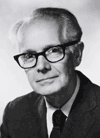KOHUT, HEINZ (1913–1981)
The psychoanalyst Heinz Kohut was born in Vienna on May 13, 1913, and died in Chicago on October 8, 1981. Kohut was an only child. His father, Felix Kohut, a businessman, was a soldier on the Russian front during the First World War. Kohut was very close to his mother, Else Lampl, and his maternal grandfather. Kohut’s parents were Jewish, but his mother had been baptized a Christian and had taken her first communion. Kohut’s childhood was filled with sadness and solitude. The family climate was cold and distant, and his parents were often busy. He had a personal tutor for studying the classics. His teachers, especially a teacher of history and geography, often served as role models. He dedicated his bookAnalyse et Gue′rison(Analysis and cure) to his tutor and to his history teacher. At the age of nineteen he began studying medicine. In 1936 he spent a year in Paris and in 1938 became a doctor of medicine.
Kohut was analyzed by Walter Marseilles, then by August Aichhorn, whose openness and skill he praised. Known to offer delinquents a magnified image of their ego ideal, Aichhorn had his own ideas about narcissism. With the rise of the Nazis, Kohut was forced to go into hiding and left Vienna shortly after Sigmund Freud.
Kohut traveled to Great Britain, where he was placed in a camp for immigrants before going to live with his maternal uncle. He left for the United States and in 1940 arrived in Chicago, where his friend Sigmund Levarie was living. He began a training analysis with Ruth Eissler, became a neurologist in 1944, became a psychiatrist in 1947, and also underwent training in analysis at the Chicago Institute for Psychoanalysis, from which he received a diploma in 1948.
He married Betty Meyer, a social worker at the institute who had been analyzed in Vienna before the war and had participated in a training seminar with Aichhorn. Betty later went into practice for herself as a therapist. Their only child, Thomas August, named in honor of August Aichhorn, with whom Kohut had maintained a correspondence over the years, became a psychohistorian and wrote a book on William II, taking inspiration from his father’s theories.
A member of the American Psychoanalytic Association, Kohut became a full member in 1953 and president in 1964. He was vice president of the International Psychoanalytical Association from 1965 to 1973. These professional activities earned him the sobriquet ‘‘Mr. Psychoanalysis.’’ He overhauled the Chicago Institute of Psychoanalysis, freeing it from the influence of Franz Alexander. He drew attention to the benefits of selecting different kinds of candidates, including nonphysicians, to avoid conformity and promote creativity. He explained that his interest in narcissism originated in the observation of his own misbehavior within various psychoanalytic societies. He felt that members’ attitudes went far beyond professional rivalry and aggression, and included elements of contempt and a lack of respect for others.
Kohut (1990–1991a) defined empathy as a key element of analysis, a viewpoint he maintained and extended throughout his life. ‘‘Forms and Transformations of Narcissism’’ (1966) and ‘‘The Psychoanalytic Treatment of Narcissistic Personality Disorders’’ (1990–1991b) introduced a new way of analyzing narcissism that culminated in the publication of The Analysis of the Self (1971) and How Does Analysis Cure? (published posthumously in 1984), Kohut’s major works on his new psychology of the self. ‘‘The Two Analyses of Mr. Z’’ (1990–1991d) relates the history of an analysis by Kohut and describes his theoretical and clinical development.
Kohut’s thought had considerable impact in the United States, and he has received widespread discussion in the psychoanalytic literature. His ideas have influenced not only his followers but also his adversaries. His importance can be compared to that of Jacques Lacan in France. He has had less impact internationally, however, and his influence varies from country to country. Narcissistic transference has been widely recognized, notwithstanding disagreement over the method of treating narcissism, but his new metapsychology was never widely accepted. Kohut’s successors have organized annual conferences and established training institutes, but they have also distanced themselves from him to develop the insights that Kohut introduced in a more personal vein.
AGNèS OPPENHEIMER
Notions developed: Action-thought (H. Kohut); Alter ego; Bipolar self; Compensatory structures; Disintegration products; Fragmentation; Grandiose self; Idealized parental imago; Idealizing transference; Mirror transference; Narcissistic rage; Narcissistic transference; Progressive neutralization; Self-object; Self psychology; Self, the; Splitting, vertical and horizontal; Transference of creativity; Transmuting internalization; Twinship transference/ alter ego transference.
See also: Act/action; Analyzability; Boredom; Borderline states; Disintegration, feelings of, (anxieties); Identity; Libido; Narcissism; Narcissistic injury; Object; Paranoia; Purified-pleasure-ego; Self; Self-image; United States.
Bibliography
Kohut, Heinz. (1966). Forms and transformations of narcissism. Journal of the American Psychoanalytic Association, 14, 243–272.
Kohut, Heinz. (1971). The analysis of the self. New York: International Universities Press.
Kohut, Heinz. (1977). The restoration of the self. New York: International Universities Press.
Kohut, Heinz. (1984). How does analysis cure? Chicago: University of Chicago Press.
Kohut, Heinz. (1990–1991a). Introspection, empathy, and psychoanalysis: an examination of the relationship between mode of observation and theory. In his The search for the self (Vol. 1, pp. 205–232). New York: International Universities Press. (Original work published 1959.)
Kohut, Heinz. (1990–1991b). The psychoanalytic treatment of narcissistic personality disorders. In his The search for the self (Vol. 1, pp. 477–509). New York: International Universities Press. (Original work published 1968.)
Kohut, Heinz. (1990–1991c). Thoughts on narcissism and narcissistic rage. In his The search for the self (Vol. 2, pp. 615– 658). New York: International Universities Press. (Original work published 1972.)
Kohut, Heinz. (1990–1991d). The two analyses of Mr. Z. In his The search for the self (Vol. 4, pp. 395–446). New York: International Universities Press. (Original work published
www.psychspace.com心理学空间网
